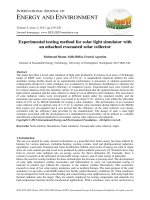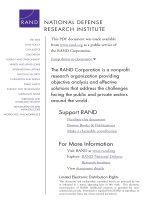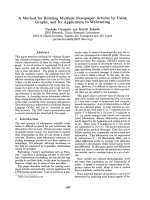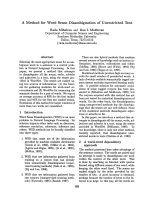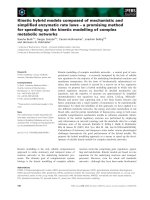A method for clustering group means with analysis of variance
Bạn đang xem bản rút gọn của tài liệu. Xem và tải ngay bản đầy đủ của tài liệu tại đây (407.41 KB, 91 trang )
A METHOD FOR CLUSTERING GROUP
MEANS WITH ANALYSIS OF VARIANCE
OU BAOLIN
NATIONAL UNIVERSITY OF SINGAPORE
2003
A METHOD FOR CLUSTERING GROUP
MEANS WITH ANALYSIS OF VARIANCE
OU BAOLIN
(B.Economics, USTC)
A THESIS SUBMITTED
FOR THE DEGREE OF MASTER OF SCIENCE
DEPARTMENT OF STATISTICS AND APPLIED PROBABILITY
NATIONAL UNIVERSITY OF SINGAPORE
2003
Acknowledgements
First and foremost, I would like to take this opportunity to express my sincere
gratitude to my supervisor Professor Yatracos Yannis. In the course of my research,
he has not only given me ample time and space to maneuver, but has also chipped
in with much needed and timely advice when I find myself stuck in the occasional
quagmire of thought.
In addition, I would like to express my heartfelt thanks to the Graduate Pro-
gramme Committee of the Department of Statistics and Applied Probability. With-
out their willingness to take a calculated risk in taking me in as a student, and
subsequently offering me the all-important research scholarship, I would not have
the financial support necessary to complete the course.
Finally, I wish to contribute the completion of this thesis to my dearest family
who have always b een supporting me with their encouragement and understanding.
And special thanks to all the staffs in my department and all my friends, who have
one way or another contributed to my thesis, for their concern and inspiration in
the two years.
i
i
Contents
Acknowledgements i
Summary iv
1 Introduction 1
1.1 The Problem . . . . . . . . . . . . . . . . . . . . . . . . . . . . . . 1
1.2 Brief Literature Review . . . . . . . . . . . . . . . . . . . . . . . . . 2
1.3 Thesis Organization . . . . . . . . . . . . . . . . . . . . . . . . . . . 6
2 The Method 8
2.1 Preliminaries . . . . . . . . . . . . . . . . . . . . . . . . . . . . . . 8
2.1.1 Basic Assumptions and Notations . . . . . . . . . . . . . . . 8
2.1.2 The Tool . . . . . . . . . . . . . . . . . . . . . . . . . . . . . 9
2.1.3 Properties of d
i
. . . . . . . . . . . . . . . . . . . . . . . . . 10
2.2 The Test Statistic . . . . . . . . . . . . . . . . . . . . . . . . . . . . 14
2.3 Description of Procedure . . . . . . . . . . . . . . . . . . . . . . . . 15
2.4 Examples . . . . . . . . . . . . . . . . . . . . . . . . . . . . . . . . 17
ii
ii
iii
3 Comparisons with Other Methods 20
3.1 Description of the Classical Methods . . . . . . . . . . . . . . . . . 20
3.1.1 Scott-Knott’s Method . . . . . . . . . . . . . . . . . . . . . 20
3.1.2 Clustering with Simultaneous F-test Procedure . . . . . . . 21
3.2 Comparison with A Numerical Example . . . . . . . . . . . . . . . 23
3.2.1 Clustering with our Method . . . . . . . . . . . . . . . . . . 24
3.2.2 Clustering with Simultaneous F-test Procedure . . . . . . . 25
3.2.3 Clustering with Scott-Knott’s Method . . . . . . . . . . . . 26
3.3 Power Comparisons for the Tests . . . . . . . . . . . . . . . . . . . 27
4 Extension of the Method 31
4.1 Location-scale Family . . . . . . . . . . . . . . . . . . . . . . . . . . 31
4.1.1 Exponential Distribution . . . . . . . . . . . . . . . . . . . . 32
4.1.2 Lognormal Distribution . . . . . . . . . . . . . . . . . . . . . 32
4.1.3 Logistic Distribution . . . . . . . . . . . . . . . . . . . . . . 33
4.2 Test Statistic . . . . . . . . . . . . . . . . . . . . . . . . . . . . . . 34
4.3 Power Comparisons under Different Distributions . . . . . . . . . . 35
Appendix 39
Bibliography 50
Program 56
Summary
In comparing treatment means, one is interested in partitioning the treatments into
groups, with hopefully the same mean for all treatments in the same group. This
makes particular sense if on general grounds, it is likely that the treatments fall
into a fairly small number of such groups.
A statistic, which appears in a decomposition of the sample variance, is used
to define a test statistic for breaking up treatment means in distinct groups of
means that are alike, or simply assert they all form one group. The observed value
is compared for significance with empirical quantiles, obtained via Monte Carlo
simulation. The test is successfully applied in examples; it is also compared with
other methods.
iv
iv
Chapter 1
Introduction
1.1 The Problem
We consider the ANOVA situation of comparing k treatment means. After being
ordered by magnitude, the sample means are X
(1)
, , X
(k)
, having expectations
µ
1
, , µ
k
. For example, Duncan (1955) quoted the results of a randomized block
experiment involving six replicates of seven varieties of barley. The varieties sample
means were:
A F G D C B E
49.6 58.1 61.0 61.5 67.6 71.2 71.3
The overall F-test shows very strong evidence of real differences among the
variety means.
In the above example, the overall significance of the F-test is very likely to have
been anticipated. The F-test only indicates whether real differences may exist, and
1
1
2
tells us very little about these differences.
When the F-test is significant, the practitioner of the analysis of variance of-
ten want to draw as many conclusions as possible about the relation of the true
means between individual treatment means (Tukey, 1949). Multiple comparison
procedures are then used to investigate the relationships between the population
means.
An alternative method, which has been less well researched, is to carry out a
cluster analysis of the means. We suppose that it is reasonable to describe any
variation in the treatment means by partitioning the treatments into groups, with
hopefully the same mean for all treatments in the same group.
In this work, our purpose is to group the treatment means into a possibly small
number of distinct but internally homogeneous clusters. That is to say, we wish
to separate the varieties into distinguishable groups as often as we can, without
too frequently separating varieties which should stay together. In this paper, one
method will be proposed whereby the population means are clustered into distinct
nonoverlapping groups.
1.2 Brief Literature Review
Tukey (1949) first recognized the importance of grouping means that are alike. He
proposed a sequence of multiple comparison procedures to accomplish this group-
ing, each based on the following intuitive criterion:
3
(1) There is an unduly wide gap b etween adjacent variety means when arranged
in order of size.
(2) One variety mean “struggles” too much from the grand mean, that is, one
variety mean is quite far away from the grand mean.
(3) The variety means taken together are too variable.
Then he used quantitative tests for detecting (1) excessive gaps, (2) stragglers,
(3) excess variability. Tukey (1953) abandoned this significance based method in
favor of confidence interval based methods.
In the later years, there was a vast literature on methods for multiple compar-
isons, such as Keuls (1952), Scheff´e (1953), Dunnett (1955), Ryan (1960), Dunn
(1961). We could find a description of such methods as well as an extended liter-
ature in Miller (1966), O’Neill and Wetherill (1971), and Hochberg and Tamhane
(1987). It was a great disadvantage of the above methods that such homogeneous
subsets are often overlapping (Calinksi and Corsten, 1985).
Edwards and Cavalli-Sforza (1965) provided a cluster method for investigating
the relationships of points in multi-dimensional space. The points were divided
into the two most-compact clusters by using an analysis of variance technique, and
4
the process was repeated sequentially so that a tree diagram was formed.
In the discussion of the review paper by O’Neill and Wetherill (1971), Plackett
(1971) suggested that we could arrange the means in rank order and plot them
against the corresponding normal scores. The object is to see whether all of the
means lie close to a single line with slope 1/S by suitable shifts where S is the
common standard error. The means which are close to one single line will make up
one group.
Scott and Knott (1974) used the techniques of cluster analysis to partition the
sample treatment means in a balanced design, and showed how a corresponding
likelihood ratio test gave a method of judging the significance of the differences
among groups obtained.
Cox and Spjφtvoll (1982) provided a simple method based directly on standard
F tests for partitioning means into groups. Complex probability calculations in-
cluding sequences of interrelated choices were avoided. The procedure may produce
several different groupings consistent with the data, and did not force an essentially
arbitrary choice among several more-or-less equally well fitting configurations.
Calinski and Corsten (1985) proposed two clustering methods, which were em-
bedded in a consistent(i.e. noncontradictory) manner into appropriate simultane-
ous test procedures. The first clustering method was a hierarchical, agglomerative,
furthest-neighbour method with the range of the union of two groups as the dis-
tance measure and with the stopping rule based on the extended Studentized range
5
STP. The second clustering method was nonhierarchical, with the sum of squares
within groups as the criterion to be minimized and the stopping rule based on an
extended F ratio STP.
Basford and Mclachlan (1985) proposed a mixture model-based approach to
this problem. Under a normal mixture model with g components, it is assumed
further that the treatment mean is distributed as N(µ
i
, σ
2
/r
i
) in the group G
i
with prob. π
i
(i = 1, , g). This mixture model can be fitted to the treatments
using the EM algorithm. A probabilistic clustering of the treatments is obtained in
terms of their fitted posterior probabilities of component membership. An outright
clustering into distinct groups is obtained by assigning each treatment mean to the
group to which it has the highest posterior probability of belonging.
Cox and Cowpertwait (1992) introduced two different statistics, which could be
used in a similar manner to cluster the population means without assuming homo-
geneity of variance. The first was the generalized likelihood ratio test statistics,
and the second was an extension of Welch’s statistics for use in testing the equality
of all the population means without assuming homogeneity of variance.
This problem continues to attract attention in recent years. Bautisa, Smith,
and Steiner (1997) proposed a cluster-based approach for means separation after
the F-test shows very strong evidence of real differences among treatments. The
procedure differs from most others in that distinct groups are created.
Yatracos (1998a) introduced a measure of dissimilarity that is based on gaps
6
but also on averages of (sub)groups. This measure is surprisingly associated with
the sample variance, in a way that leads to a new interpretation of the notion of
variance but also to a measure of divergence of separated populations. Later in his
unpublished manuscript (1998b), he proposed a one-step method for breaking up
treatment means.
1.3 Thesis Organization
This thesis is organized as follows:
In Chapter 2, some preliminaries and notations to be used are provided. As-
suming the homogeneity of variance and the same sample size in every treatment,
the test statistic is defined for normal sample means. Then, the classification pro-
cess is explained in detail. The critical values for comparison are provided from
Monte Carlo simulation.
In Chapter 3, some classical grouping methods are introduced, such as the
Scott-Knott’s Test, and clustering by F-test STP. These methods are applied in
a numerical example for comparing the outcomes with the proposed method. At
last the power of our method is compared with these methods using Monte Carlo
simulation.
In Chapter 4, our method is extended to the distribution in the location-scale
family. The test statistic is the same as that in the normal condition and the critical
values for comparison are provided also from Monte Carlo simulation. Finally,
7
the powers of the tests for these distributions are compared using Monte Carlo
simulation.
Chapter 2
The Method
2.1 Preliminaries
2.1.1 Basic Assumptions and Notations
Let X
ij
, i=1, ,k, j=1, ,m, be observations from normal populations obtained
when applying k different independent treatments N(µ
i
, σ
2
), Let
¯
X be the grand
mean,
¯
X
1.
, ,
¯
X
k.
be the observed treatments means, X
(1)
, , X
(k)
be the corre-
sponding ordered means and µ
i,j:k
=E[X
(i)
X
(j)
]. From the ANOVA model, the
total sum of squares is
SS
T
=
k
i=1
m
j=1
(X
ij
−
¯
X )
2
,
the sum of squares within groups
SS
W
=
k
i=1
m
j=1
(X
ij
−
¯
X
i.
)
2
,
8
8
9
and the sum of squares between groups is
SS
B
= m
k
i=1
(
¯
X
i.
−
¯
X )
2
.
Furthermore, SS
T
= SS
B
+SS
W
and the mean square within groups is MS
W
=
SS
W
k(m−1)
.
2.1.2 The Tool
In cluster analysis, real observations Y
1
, , Y
n
are divided into two clusters each
containing objects far apart from those in the other, with respect to a dissimilarity
measure. Let Y
(1)
, , Y
(k)
be the corresponding order statistic and
¯
Y
(i)
,
¯
Y
(n−i)
be the
averages of the i smallest and (n-i) largest observations. Yatracos (1998a) proved
that
n
i=1
(Y
i
−
¯
Y )
2
=
n−1
i=1
i(n−i)
n
(
¯
Y
(n−i)
−
¯
Y
(i)
)(Y
(i+1)
− Y
(i)
).
The total variance of the observations is decomposed as the sum of the diver-
gence measures
i(n−i)
n
(
¯
Y
(n−i)
−
¯
Y
(i)
)(Y
(i+1)
− Y
(i)
) of separated populations leading
to a new interpretation of the sample variance. The term that contributes the most
in the sample variance determines the potential clusters.
Then, to divide the treatments means
¯
X
1.
, ,
¯
X
k.
, it is enough to examine the
i smallest observations X
(1)
, , X
(i)
and (k-i) largest observations X
(i+1)
, , X
(k)
for i=1, ,k-1. For any given i, let
¯
X
[1,i]
=
X
(1)
+ +X
(i)
i
,
¯
X
[i+1,k]
=
X
(i+1)
+ +X
(k)
k−i
, be
10
the averages of the i smallest and (k-i) largest observations, i=1, ,k-1. Following
Yatracos theorem, it holds:
k
i=1
(
¯
X
i.
−
¯
X )
2
=
k−1
i=1
i(k−i)
k
(
¯
X
[i+1,k]
−
¯
X
[1,i]
)(X
(i+1)
− X
(i)
),
and we define
d
i
=
i(k−i)
k
(
¯
X
[i+1,k]
−
¯
X
[1,i]
)(X
(i+1)
− X
(i)
).
So, the between group sums of squares SS
B
=m
k−1
i=1
d
i
.
2.1.3 Properties of d
i
The following lemmas will be used.
Lemma 1 Let Y
1
, , Y
k
be the samples from the standard normal distribution
and Y
(1)
, , Y
(k)
be the corresponding order statistic, and µ
i,j:k
=E[Y
(i)
Y
(j)
]. Then
we have
k
j=1
µ
i,j:k
= 1, i=1, ,k;
see Arnold et. al, 1992, p.91.
In other words, in a row or column of the product -moment matrix E[Y
(i)
Y
(j)
]
the sum of the elements is 1 for any sample size k.
Lemma 2 With the same assumptions as in Lemma 1, we have
11
k
j=i
µ
i,j:k
−
k
j=i
µ
i−1,j:k
= 1, i = 1, , k.
For proof, see Joshi and Balakrishnan. (1981).
From Lemma 1, we can also write
i−1
j=1
µ
i−1,j:k
−
i−1
j=1
µ
i,j:k
= 1, which is
equivalent to
i
j=1
µ
i,j:k
−
i
j=1
µ
i+1,j:k
= 1.
Proposition 2.1 Let X
ij
, i=1, ,k, j=1, ,m, be the independent observations
from the standard normal distribution when applying k different treatments. If
all the sample means X
1.
, , X
k.
are from the same group, let X
(1)
, , X
(k)
be the
corresponding ordered means and let d
i
=
i(k−i)
k
(
¯
X
[i+1,k]
−
¯
X
[1,i]
)(X
(i+1)
− X
(i)
).
Then Ed
i
=1/m, for any i=1,2, ,k-1.
Proof:
From the definition of d
i
,
Ed
i
=E
i(k−i)
k
(
¯
X
[i+1,k]
−
¯
X
[1,i]
)(X
(i+1)
− X
(i)
).
Since
¯
X
[1,i]
=
X
(1)
+ +X
(i)
i
,
¯
X
[i+1,k]
=
X
(i+1)
+ +X
(k)
k−i
.
Then
12
Ed
i
=
1
k
E([i(X
(i+1)
+ + X
(k)
) − (k − i)(X
(1)
+ + X
(i)
)](X
(i+1)
− X
(i)
))
=
1
k
E(i
k
j=1
X
(j)
− k
i
j=1
X
(j)
)(X
(i+1)
− X
(i)
)
=
i
k
E
k
j=1
X
(j)
(X
(i+1)
− X
(i)
)-E
i
j=1
X
(j)
(X
(i+1)
− X
(i)
)
= T
1,i
− T
2,i
; (2.1)
T
1,i
=E
i
k
k
j=1
X
(j)
(X
(i+1)
− X
(i)
) and T
2,i
=E
i
j=1
X
(j)
(X
(i+1)
− X
(i)
). We look
at T
1,i
.
Since every treatment mean comes from the standard normal distribution,
¯
X
1.
, ,
¯
X
k.
will follow the normal distribution N(0,
1
m
).
Let
¯
X
1.
=
Y
1
√
m
, ,
¯
X
k.
=
Y
k
√
m
. Then Y
1
, , Y
k
will follow the standard normal
distribution.
From lemma 1,
T
1,i
=
i
km
(
k
j=1
µ
i+1,j:k
−
k
j=1
µ
i,j:k
)
=
i
km
(1 − 1) = 0.
Finally we look at T
2,i
, i=1, ,k-1.
T
2,i
=E
i
j=1
X
(j)
(X
(i+1)
− X
(i)
)
=
1
m
(
i
j=1
µ
i+1,j:k
−
i
j=1
µ
i,j:k
).
From lemma 2,
13
T
2,i
= −
1
m
.
so
Ed
i
=T
1,i
− T
2,i
=0+
1
m
=
1
m
.
Extension of proposition 2.1 Let X
ij
, i=1, ,k, j=1, ,m, be the observa-
tions from the normal distribution N(µ, σ
2
) when applying k different treatments.
If all the sample means X
1.
, , X
k.
are from the same group, let X
(1)
, , X
(k)
be
the corresponding ordered means and d
i
=
i(k−i)
k
(
¯
X
[i+1,k]
−
¯
X
[1,i]
)(X
(i+1)
− X
(i)
),
then Ed
i
=σ
2
/m, for any i=1,2, ,k-1.
Proof:
Denote Y
ij
=
X
ij
−µ
σ
, Let Y
i.
and Y
(i)
be the corresponding sample mean and order
statistic, then
Ed
i
=σ
2
E
i(k−i)
k
(
¯
Y
[i+1,k]
−
¯
Y
[1,i]
)(Y
(i+1)
− Y
(i)
).
From proposition 2.1, Ed
i
=σ
2
/m, for any i=1,2, ,k-1.
14
2.2 The Test Statistic
For two groups of means, the hypothesis is that
H
0
: µ
i
= µ, i = 1, , k
H
1
: µ
i
is either equal to m
1
or m
2
(with at least one mean in each group),i=1, ,k
where m
1
and m
2
represent the unknown means of the two groups and the
variances for both hypotheses are the same. Then we define the test statistic
T =
m×max(d
i
)
s
2
, i=1, ,k-1
where s
2
is the mean square within groups
s
2
=
SS
W
k(m−1)
=
k
i=1
m
j=1
(X
ij
−
¯
X
i.
)
2
k(m−1)
Proposition 2.2 Under the null hypothesis H
0
, the pdf of the test statistic T
is independent of the parameter µ, σ.
Proof:
T =
m×max(d
i
)
s
2
, i=1, ,k-1
15
=
m×max(
i(k−i)
k
(
¯
X
(i+1,k)
−
¯
X
(1,i)
)(X
(i+1)
−X
(i)
)
k
i=1
m
j=1
(X
ij
−
¯
X
i.
)
2
k(m−1)
Suppose X
ij
, i=1, ,k, j=1, m, be observations coming from the normal dis-
tribution N(µ, σ
2
). Let Y
ij
=
X
ij
−µ
σ
, and Y
i.
and Y
(i)
be the corresponding sample
mean and its order statistic.
So we can equivalently rewrite the test statistic T as
m×max(
i(k−i)
k
(
¯
Y
(i+1,k)
−
¯
Y
(1,i)
)(Y
(i+1)
−Y
(i)
)
k
i=1
m
j=1
(Y
ij
−
¯
Y
i.
)
2
k(m−1)
, i=1, ,k-1
Since the distribution of Y
ij
does not involve the parameters µ and σ, the pdf
of the test statistic T is independent of them.
From proposition 2.2, the distribution of T under the null hypothesis is in-
dependent of the unknown parameters of µ and σ. The critical values for the
empirical distribution of the statistic T has been obtained using 10,000 samples.
See appendix Table 1.
2.3 Description of Procedure
From the definition of d
i
, we can see that max(d
i
) is large under H
1
. Furthermore,
the larger of the difference between the two group means, the larger of the value
max(d
i
). So the test for the null hypothesis against the alternative hypothesis is
equivalent to a test that rejects H
0
if T =
m×max(d
i
)
s
2
, i=1, ,k-1 is too large. The
16
two groups are determined at the same time when the null hypothesis is rejected.
For example, if the test is rejected and d
p
is the maximum of d
i
, then the means
(1, ,p) form one group and means (p+1, ,k-1) form the other group.
This method requires the null distribution of the test statistic T. But the deriva-
tion of the distribution is very complicated to handle in practice. Fortunately from
the proposition 2.2, we can use empirical quantiles of the standard normal distribu-
tion having the same treatment groups k and sample size m since the test statistic
T is independent of the parameter.
The null hypothesis will be accepted if T is less than or equal to C
k,m,α
, where
C
k,m,α
is determined by Monte Carlo simulations so that the probability of rejecting
H
0
is equal to α.
In real problems, it may not b e enough to cluster the means into only two
groups. There may exist three or more groups. In such a case, we adopt the
hierarchical splitting method suggested by Edwards and Cavalli-Sforza (1965) in
their work on cluster analysis.
At the beginning, the treatment means will be split into two groups, based on
the value of T compared with the critical value C
k,m,α
obtained from Monte Carlo
simulations. The same procedure will be applied separately to each subgroup
in turn. The process will continue until the resulting groups are judged to be
homogeneous by application of the above test. This method is simple to apply, and
it is often easier to interpret the results in an unambiguous way with a hierarchical
17
method in which the groups at any stage are related to those of the previous stage.
2.4 Examples
Example 1.
This example was analysed by Duncan (1955) and later by Scott and Knott
(1974). The yields(bushels per acre) of seven barley varieties were compared in a
complete block design of six blocks. The sample means were
x
(1)
x
(2)
x
(3)
x
(4)
x
(5)
x
(6)
x
(7)
49.6 58.1 61.0 61.5 67.6 71.2 71.3
s
2
= 79.64 and k=m=7.
The breakdown of the means is
(1 − 7)
✒
❅
❅
❅
❅
❅
❅❘
T =
m×max(d
i
)
s
2
= 11.47
(1 − 4)
(5 − 7)
T = 5.94
T = 0.78
At first, compute the value of T based on means (1-7) which is 11.47 and d
4
is the
maximum of d
i
i=1, ,7. Since 11.47 is larger than the cricital vaule C
7,7,0.05
=6.50,
18
(1-4) form one group and (4-7) form the other group. For subgroups (1-4) and
(5-7), compute the values of T again, which are smaller than the critical value. So
it leads to the final grouping (1-4)(5-7) in this example according to our method.
This result is close to the result obtained by Scott and Knott (1974), and is the
same with the result obtained by Calinski and Corsten (1985).
Example 2.
This example was presented in Snedecor (1946), and was also analysed by Tukey
(1949) and Scott and Knott (1974). It is concerned with a 7 × 7 Latin square ex-
periment about the yields(bushels per acre) of potato varieties. The sample means
were
x
(1)
x
(2)
x
(3)
x
(4)
x
(5)
x
(6)
x
(7)
341.9 360.4 360.6 363.1 379.9 386.3 387.1
s
2
= 635 and k=m=7.
The breakdown of the means is given below.
19
(1 − 7)
✒
❅
❅
❅
❅
❅
❅❘
T =
m×max(d
i
)
s
2
= 8.87
(1 − 4)
(5 − 7)
T = 2.97
T = 0.32
At first, compute the value of T based on means (1-7) which is 8.87 and d
4
is the
maximum of d
i
i=1, ,7. Since 8.87 is larger than the cricital value C
7,7,0.05
=6.50,
(1-4) form one group and (4-7) form the other group. For subgroups (1-4) and
(5-7), compute the values of T again, which are smaller than the critical value. So
it leads to the final grouping (1-4)(5-7) in this example according to our method.
This result is the same as the result obtained by Scott and Knott (1974).
